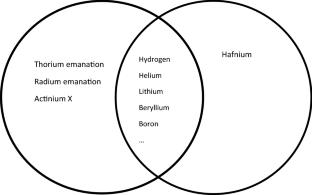当化学家开始按原子序数对元素进行分类时,发生了什么?
IF 1.8
3区 化学
Q1 HISTORY & PHILOSOPHY OF SCIENCE
引用次数: 2
摘要
我认为在20世纪初发生了一场化学科学革命,而塞里最近对我的观点做出了回应。我承认,正如塞里所坚持的那样,在我们所争论的变化中存在着重要的连续性。所有的科学革命都是如此。但我认为,这些变化构成了库恩式的革命,不是《科学革命的结构》中经典意义上的革命,而是库恩在20世纪80年代和90年代初发展起来的成熟理论。本文章由计算机程序翻译,如有差异,请以英文原文为准。

What happened when chemists came to classify elements by their atomic number?
I respond to Scerri’s recent reply to my claim that there was a scientific revolution in chemistry in the early twentieth Century. I grant, as Scerri insists, that there are significant continuities through the change about which we are arguing. That is so in all scientific revolutions. But I argue that the changes were such that they constitute a Kuhnian revolution, not in the classic sense of The Structure of Scientific Revolutions, but in the sense of Kuhn’s mature theory, developed in the 1980s and early 1990s.
求助全文
通过发布文献求助,成功后即可免费获取论文全文。
去求助
来源期刊

Foundations of Chemistry
HISTORY & PHILOSOPHY OF SCIENCE-
自引率
22.20%
发文量
35
期刊介绍:
Foundations of Chemistry is an international journal which seeks to provide an interdisciplinary forum where chemists, biochemists, philosophers, historians, educators and sociologists with an interest in foundational issues can discuss conceptual and fundamental issues which relate to the `central science'' of chemistry. Such issues include the autonomous role of chemistry between physics and biology and the question of the reduction of chemistry to quantum mechanics. The journal will publish peer-reviewed academic articles on a wide range of subdisciplines, among others: chemical models, chemical language, metaphors, and theoretical terms; chemical evolution and artificial self-replication; industrial application, environmental concern, and the social and ethical aspects of chemistry''s professionalism; the nature of modeling and the role of instrumentation in chemistry; institutional studies and the nature of explanation in the chemical sciences; theoretical chemistry, molecular structure and chaos; the issue of realism; molecular biology, bio-inorganic chemistry; historical studies on ancient chemistry, medieval chemistry and alchemy; philosophical and historical articles; and material of a didactic nature relating to all topics in the chemical sciences. Foundations of Chemistry plans to feature special issues devoted to particular themes, and will contain book reviews and discussion notes. Audience: chemists, biochemists, philosophers, historians, chemical educators, sociologists, and other scientists with an interest in the foundational issues of science.
 求助内容:
求助内容: 应助结果提醒方式:
应助结果提醒方式:


